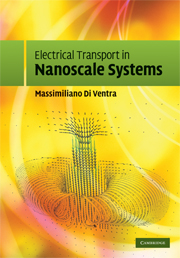Book contents
- Frontmatter
- Contents
- Preface
- 1 A primer on electron transport
- 2 Drude model, Kubo formalism and Boltzmann equation
- 3 Landauer approach
- 4 Non-equilibrium Green's function formalism
- 5 Noise
- 6 Electron-ion interaction
- 7 The micro-canonical picture of transport
- 8 Hydrodynamics of the electron liquid
- Appendices
- References
- Index
5 - Noise
Published online by Cambridge University Press: 06 July 2010
- Frontmatter
- Contents
- Preface
- 1 A primer on electron transport
- 2 Drude model, Kubo formalism and Boltzmann equation
- 3 Landauer approach
- 4 Non-equilibrium Green's function formalism
- 5 Noise
- 6 Electron-ion interaction
- 7 The micro-canonical picture of transport
- 8 Hydrodynamics of the electron liquid
- Appendices
- References
- Index
Summary
So far I have discussed the most obvious quantity in a transport problem: the average current. In reality, as I have anticipated in Sec. 1.2, electrical current continually fluctuates in time so that it carries noise.
There are several sources of noise in a conductor that can be classified as external and internal. Two of the most common sources of external noise are known as 1/f and telegraph noise. The first takes its name from the fact that it shows a spectrum at small frequencies f, which scales as 1/f. No general theory exists on this noise, and it is believed to be of extrinsic origin, for instance due to distributions of defects in the conductor. The interested reader should consult the review by Dutta and Horn (1981) where 1/f noise is discussed at length.
On the other hand, telegraph noise is due to rapid fluctuations between states of the conductor that are very close in energy, but that carry different currents. This noise is also believed to be of extrinsic nature and has a typical Lorentzian power spectrum.
In addition to the above fluctuations, one has to remember that our nanoscale system (sample), whose noise properties we want to determine, is connected to a real external circuit with its own external resistance, call it Rext (Fig. 5.1). Therefore, due to the presence of this extra resistance, even if the voltage source is noiseless (call the corresponding potential drop Vsource), the voltage drop across the sample (call it Vsample) is different from Vsource and would manifest fluctuations. This is easy to see using the following simple arguments.
- Type
- Chapter
- Information
- Electrical Transport in Nanoscale Systems , pp. 258 - 279Publisher: Cambridge University PressPrint publication year: 2008



